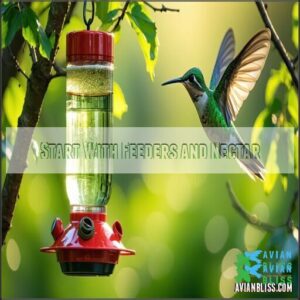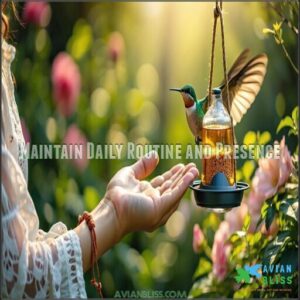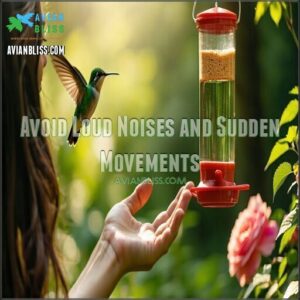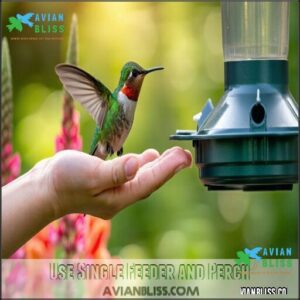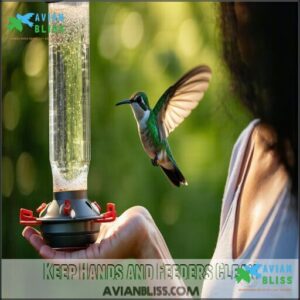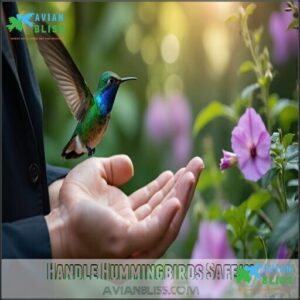This site is supported by our readers. We may earn a commission, at no cost to you, if you purchase through links.
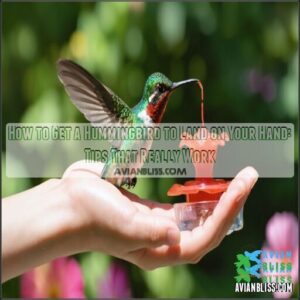 To get a hummingbird to land on your hand, start by earning their trust. Set up a feeder or offer sugar water (1 part sugar to 4 parts water) in a bright red cup or dish.
To get a hummingbird to land on your hand, start by earning their trust. Set up a feeder or offer sugar water (1 part sugar to 4 parts water) in a bright red cup or dish.
Wear red or bright colors to mimic flowers, and hold still—they’ll only approach if you’re calm and patient. Position yourself near the feeder daily so they recognize you.
When they’re used to your presence, slowly move the feeder to your hand. Avoid sudden movements or noise, as they spook easily. With persistence, you’ll become their new favorite perch.
Ready to impress these winged jewels further?
Table Of Contents
- Key Takeaways
- Attract Hummingbirds Effectively
- Get Hummingbirds to Land
- Build Trust With Hummingbirds
- Handle Hummingbirds Safely
- Enhance Hummingbird Interaction
- Frequently Asked Questions (FAQs)
- How can I make a hummingbird land on me?
- How do you pick up a hummingbird?
- How do you get a hummingbird to trust you?
- What is the hummingbird way?
- How do you know if a hummingbird is in Your House?
- How to get a hummingbird to sit in your hand?
- How do you get a hummingbird to like you?
- How to attract hummingbirds to your yard?
- How can I get hummingbirds to land on my hand?
- How to get a hummingbird to sit on your hand?
- Conclusion
Key Takeaways
- Wear bright colors like red to mimic flowers and attract hummingbirds’ attention.
- Stand still near a feeder daily to build trust and help them get used to your presence.
- Gradually move the feeder to your hand, keeping movements slow and steady to avoid startling them.
- Use clean feeders filled with a fresh nectar mix (1 part sugar to 4 parts water) to maintain their interest and safety.
Attract Hummingbirds Effectively
You can attract hummingbirds by planting native flowering plants with vibrant, tubular blooms and using feeders with fresh nectar.
Adding red accents and providing a water feature, like a mister or fountain, will make your garden irresistible to these fascinating little birds.
Red accents and sparkling water features transform your garden into an irresistible haven for hummingbirds, captivating their tiny, vibrant hearts.
Plant Native Colorful Flowers
Native flower selection is key to a hummingbird garden design. Choose tubular flower shapes like trumpet honeysuckle or bee balm—they’re irresistible to hummingbirds.
Group flowers closely (concentrated flower placement) for easy access and a consistent nectar source. You can find more information about hummingbird-friendly flower options.
This creates a welcoming spot, boosting hummingbird trust-building and encouraging eventual hand feeding. Your vibrant garden will become their favorite hangout!
Use Red Accents and Feeders
Attracting hummingbirds starts with bold use of red—a color they adore.
Hang a well-placed single feeder with thoughtful design safety, like bee guards, to minimize pests.
Position your feeder where it’s visible and away from predators, as the red color attraction taps into their instincts, making it easier to bring them closer.
You can find a quality feeder here, which is a simple, effective hand feeding tip!
Provide Consistent Food Source
Keeping hummingbirds loyal means dependable nectar consistency.
Fill feeders regularly with fresh nectar—four parts water, one part sugar.
Feeder placement matters; choose shaded spots to prevent spoilage.
Seasonal adjustments, like offering extra nectar during migration, can help too.
Natural sources, like bee balm or sage, complement feeders.
With these simple hand feeding tips, hummingbird trust building becomes easier, fostering memorable interactions through hummingbird trust.
Create Water Feature for Bathing
How do you make hummingbirds truly feel at home? Install a mister or drip fountain – they love the motion and sparkle of water.
Birdbath options with shallow edges also work well as a water source. Keep it spotless (cleaning frequency matters!) to build trust.
Shallow water designs are essential for hummingbird safety and comfort. These steps weave into hummingbird trust building and hand feeding tips, making birds feel comfortable.
Get Hummingbirds to Land
Getting a hummingbird to land on your hand takes patience, consistency, and the right approach.
By offering nectar, wearing attractive colors, and moving slowly, you can gradually build their trust and create an unforgettable experience.
Gradual trust-building with hummingbirds creates magical moments as they hover close, turning your garden into a haven of vibrant life.
Start With Feeders and Nectar
Start with feeders to catch their attention.
Place them in shaded spots and fill them with fresh nectar for consistency.
Use feeder types like those with ant moats to keep pests away.
Simple nectar recipes—just sugar and water—work best.
For hummingbird hand feeding, pick one feeder, keep it clean, and stick to a routine.
Patience brings success.
Wear Attractive Colors and Clothing
Bright, warm colors like red, orange, and yellow aren’t just eye-catching—they play into hummingbirds’ color psychology.
Slip on a red shirt or scarf to boost your chances of handfeeding success.
Fabric choices matter too; avoid loud, shiny clothing that might spook them, and keep it comfortable and seasonal, blending your clothing with surroundings for attracting hummingbirds naturally, without scaring them away, using warm colors.
Move Slowly and Maintain Consistency
Patience is your best tool for hummingbird hand feeding.
A gradual approach builds trust—stand calmly near feeders daily, wearing consistent attire.
Routine benefits the process as hummingbirds recognize you, minimizing fear.
Avoid sudden moves; their comfort grows with steady observation.
With consistency, they’ll associate you with safety and master patience, and you’ll soon feel trust in the hum of their wings.
Offer Nectar From Hand
After staying consistent around feeders, you’re ready for hummingbird hand feeding.
Use Nectar Dots or a small feeder in your palm.
Keep it steady and prioritize hand cleanliness to match the nectar consistency they expect.
Position near popular feeder spots, and offer perch alternatives like fingers.
These are often sold as convenient nectar solutions.
Bird comfort builds trust—stay calm as hummingbirds explore this new, intimate feeding experience.
Build Trust With Hummingbirds
Building trust with hummingbirds takes patience, consistency, and a calm presence.
By sticking to a daily routine, minimizing sudden movements, and keeping feeders clean, you’ll help these curious birds feel safe enough to approach.
Maintain Daily Routine and Presence
Building trust with hummingbirds takes consistency and patience. Stick to a daily schedule, showing up at the same time to establish familiarity. A gradual approach helps them feel safe around you.
- Wear familiar attire to reinforce recognition patterns.
- Be consistent with timing to boost bird-human interaction.
- Observe patiently and avoid sudden moves.
- Maintain a quiet demeanor during hand-feeding attempts to establish trust.
Avoid Loud Noises and Sudden Movements
When introducing hand feeding, avoid sharp noises or quick moves—they’re startling to hummingbirds, whose sensitivity to movement rivals their sharp sight.
A calm approach builds bird trust, so movements should flow like a soft breeze. Noise sensitivity also matters; talk softly or stay quiet.
Remember, patience wins. Don’t rush; let their curiosity trump their caution.
| Mistake | Impact on Hummingbirds | Solution |
|---|---|---|
| Sudden movements | Scares birds away | Move gently and slowly |
| Loud noises | Triggers alertness | Create a quiet space |
| Fast hand gestures | Breaks trust | Use calm, steady motions |
| Startling sounds | Makes birds retreat | Reduce ambient noise |
| Impatience | Delays progress | Stay calm and patient |
Use Single Feeder and Perch
Using a single feeder simplifies feeder placement and encourages perching.
Opt for a perch design like Cole’s Hummer High Rise Feeder to make hummingbirds feel safe.
Focus their attention by removing other feeders temporarily.
Position yourself near the feeder and hold it steady to promote hand feeding.
With patience and trust, hummingbirds may land gracefully on your offered perch.
To further entice them, consider planting native flowers to create a hummingbird-friendly environment.
Keep Hands and Feeders Clean
Cleanliness builds trust! Wash your hands before handling a feeder to keep nectar pure and prevent hummingbird illnesses.
Use safe cleaning techniques like scrubbing feeders with hot water every three days to stop nectar spoilage. Place feeders in shaded locations to slow fermentation.
Don’t forget ant moats—they block pests. A clean hand and feeder invite more visits, emphasizing the importance of cleanliness.
Handle Hummingbirds Safely
When handling hummingbirds, focus on their safety by avoiding contact with their delicate wings and heads.
Keep young children and pets at a distance to minimize stress and prevent accidental harm, ensuring the safety of these delicate creatures is prioritized.
Avoid Touching Wings and Heads
Respect is the name of the game when attracting hummingbirds to your hand.
Their delicate feathers are easily damaged, so don’t touch their wings or heads.
Gentle handling isn’t just about safety—it builds trust and reduces stress.
Safe observation reveals fascinating hummingbird behavior without harm.
Treat them as shy guests, and they’ll reward you with unforgettable moments of fascinating hummingbird behavior.
Keep Children and Pets Away
To protect hummingbirds and build trust, keep young kids and pets away. Their quick movements can frighten birds or cause unintentional harm.
For safe supervision, it is essential to follow a few guidelines.
- Create a child-friendly viewing spot far from feeders.
- Teach kids to admire without chasing.
- Keep pets indoors during hand-feeding attempts.
Adding fencing to guard your garden is also crucial, as it protects buzzing visitors while ensuring everyone enjoys hummingbird behavior peacefully. Cats are significant threats, so keeping cats indoors is essential to prevent harm, allowing you to observe beautiful creatures and their fascinating antics.
Prioritize Bird Safety and Comfort
Hummingbirds need tender care to thrive. Always prioritize feather protection and safe handling by letting them land freely.
Gentle rescue is key to collision prevention—avoiding stress builds trust. Ethical observation also fosters bird comfort.
Avoid touching wings or heads, as they’re delicate. Focus on gaining bird trust, ensuring both bird safety and your hand remain a welcome perch.
| Action | Do This | Don’t Do This |
|---|---|---|
| Handling Birds | Be gentle and patient | Grab or restrain them |
| Feather Protection | Allow natural movement | Touch or ruffle feathers |
| Bird Safety | Observe calmly, offering a stable hand perch | Chase or act unpredictably |
Release Caught Hummingbirds Promptly
If a hummingbird ends up in your hand, let it go quickly to prevent stress.
Keep your grip gentle to avoid harming its fragile wings or body.
Choose a safe release location, like a shaded spot away from predators.
Proper handling techniques guarantee no injuries.
Always prioritize the bird’s well-being over curiosity, letting it fly freely again.
Enhance Hummingbird Interaction
You can strengthen your connection with hummingbirds by observing their behavior and making small adjustments to your environment.
Simple changes, like fine-tuning nectar recipes or offering a safe perch, will encourage these tiny creatures to trust you, which can lead to a deeper understanding and connection with them.
Train Hummingbirds to Perch on Finger
Begin by offering your finger close to a feeder port, mimicking a twig for comfort.
Use consistent hand placement and wear bright red or orange to boost attire color impact.
Practice patience and persistence—hummingbird training methods take time.
Gradual nectar shifts and staying still help attract hummingbirds to your hand.
Building trust is key for successful finger perch training.
Recognize and Respond to Behavior
Get a read on your feathery friend’s vibe. Understanding hummingbird behavior makes hand training easier.
Watch for signs like fluffed feathers or sharp calls:
- Reading Body Language: Calm birds approach confidently.
- Interpreting Calls: Chirps signal curiosity; aggression means stay back.
- Recognizing Fear: Hovering hesitation equals nervousness.
It’s also important to recognize signs of illness to guarantee their well-being.
- Understanding Aggression: Guarding feeders loudly? Territorial.
- Responding Appropriately: Stay calm, avoid sudden moves.
Create Hummingbird-Friendly Environment
Imagine your yard as a hummingbird paradise.
Plant native flowers like trumpet creeper and sage for nectar, keep feeders spaced to reduce fights, and add water sources like misters.
Make certain shade placement for cooler spots and practice natural insect control.
These hummingbird garden ideas attract wild birds while offering everything needed to land, feed, and stay comfortable.
Adjust Nectar Recipes for Seasons
Different seasons call for tweaks to your hummingbird nectar recipe.
- Use a 1:4 refined sugar-to-water ratio—perfect for any temperature.
- Boil for three minutes for safe nectar density.
- Clean feeders twice weekly in hot weather.
- Cut to weekly cleanings when it’s cooler.
- Remember, fresh sugar water guarantees happy, healthy birds and better hand-feeding success!
Frequently Asked Questions (FAQs)
How can I make a hummingbird land on me?
Picture sunlight dancing through garden leaves; wear red or orange to catch a hummingbird’s eye.
Stay still, hold a small feeder or dish of nectar steady, and wait patiently.
Trust builds; landing follows.
How do you pick up a hummingbird?
To pick up a hummingbird, approach it gently with steady hands, ensuring it’s calm and safe.
Avoid touching its wings or head, as they’re fragile.
Handle it minimally, and release it quickly to prevent stress.
How do you get a hummingbird to trust you?
Stand near their feeder daily, stay calm, move slowly, and wear red or bright colors.
Use a small hand feeder, keeping it steady.
Stay consistent and patient—trust takes time, but they’ll recognize your presence.
What is the hummingbird way?
The hummingbird way means patience, consistency, and trust.
Show up daily near feeders, stay calm, and avoid sudden moves.
Wear red, hold still, and let them decide when to approach—you’re earning their tiny, bold trust.
How do you know if a hummingbird is in Your House?
You might notice the buzzing of wings or spot a flash of vibrant feathers darting around.
Hummingbirds often get trapped near windows or lights, mistaking them for open skies.
Listen closely—they chirp, too!
How to get a hummingbird to sit in your hand?
Hold a small feeder steadily near an active feeding spot, wear red to catch their eye, and stay perfectly still.
Patience is key—building trust takes time, but persistence can lead to magical moments.
How do you get a hummingbird to like you?
Imagine this: a tiny jewel darting near you.
Build trust by staying still, wearing vibrant red, and offering nectar.
Be consistent, patient, and calm.
Over time, they’ll see you as part of their world.
How to attract hummingbirds to your yard?
Plant native, tubular flowers like trumpet honeysuckle or bee balm, and hang a red-accented feeder filled with sugar water.
Add a drip fountain for water-loving charm, and soon they’ll visit your yard regularly!
How can I get hummingbirds to land on my hand?
Think of building trust like planting seeds—show up consistently, stay still, and wear red.
Gradually hold a tiny nectar-filled feeder, offering your hand as a perch.
Patience transforms curiosity into unforgettable close encounters.
How to get a hummingbird to sit on your hand?
Start by standing still near a feeder every day, wearing red to attract curiosity.
Hold a feeder or a small dish of nectar in your hand; patience and steady movements will build their trust.
Conclusion
Earning a hummingbird’s trust is like building a delicate bridge—steady, patient efforts lead to success.
Follow the steps above, providing food, wearing inviting colors, and staying calm to create a welcoming environment.
Over time, they’ll grow comfortable, and you’ll master how to get a hummingbird to land on your hand.
Remember, consistency and care are key, so avoid loud noises or sudden moves.
With persistence, these remarkable birds can become a close and breathtaking part of your day.
- https://www.birdsandblooms.com/birding/attracting-hummingbirds/top-10-colorful-flowers-hummingbirds-love/
- https://www.audubon.org/news/the-origins-hummingbirds-are-still-major-mystery
- https://www.brandpointcontent.com/article/32677/dos-and-donts-of-attracting-hummingbirds-and-getting-one-to-land-on-your-hand
- https://youtu.be/QIpC3BSVP70
- https://www.google.com/chrome/


